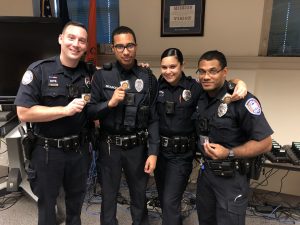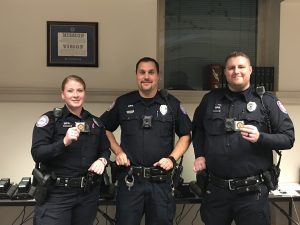
At the end of last week, we held challenge coin ceremony’s for our seven officers who recently completed their field training. Never heard of a challenge coin ceremony? Learn the history below:
During WWI, American volunteers from all parts of the country filled the newly formed flying squadrons. Some were wealthy scions attending colleges such as Harvard and Yale who quit mid-term to join the war. In one squadron a lieutenant ordered medallions struck on solid bronze carrying the squadron emblem for every member of his squadron. He carried his medallion in a pouch around his neck. Shortly after acquiring the medallions, the pilot’s aircraft was severely damaged by ground fire. He was forced to land behind enemy lines and was immediately captured by a German patrol. In order to discourage his escape, the Germans took his uniform and all personal identification except for the small leather pouch around his neck not realizing the significance of the coin.
Taking advantage of a bombardment that night, he escaped. However, he was without personal identification. He succeeded in avoiding German patrols and reached the front lines. With great difficulty he crossed no-man’s land. Eventually he stumbled into a French outpost. Unfortunately, the

French in his sector had been plagued by saboteurs. The saboteurs sometimes masqueraded as civilians and wore civilian clothes. Not recognizing the young pilot’s American accent and since he
had no uniform or any form or identification, the French thought he was a saboteur and were going to execute him. Just in time he remembered the coin in the leather pouch. He showed the coin
to his would be executioners. His French captors recognized the squadron symbol on the coin and delayed long enough to confirm his identity whereupon they shared a bottle of wine with him. They were challenging him to prove that he was one of them, that they shared the same cause and
the coin saved his life.
Back at his squadron, and after hearing his story, it became a tradition to ensure that all members carried their coin at all times. This was accomplished by a challenge conducted in the following manner:
Challenge Coin Rules
- The challenge is initiated by drawing your coin, holding it in the air by whatever means possible and state, shout or otherwise verbally acknowledge that you are initiating a coin check. You may also place it or strike it on a hard surface such as a table. If you accidentally drop your coin and it makes an audible sound it is still considered a challenge.
- The response consists of all those present responding in a like manner within 15 seconds. At the time of the challenge you are allowed one step and an arm’s reach to locate your coin. All coin holders present will participate during a challenge. A response can be with any other challenge coin.
- If there is a challenge and a person is unable to respond then the individual(s) without their coin are required to buy a meal and or beverage of choice for the individual who issued the challenge.
- If everyone being challenged responds with their coin then the person who challenged is required to buy a meal for all those he/she challenged.
- Failure to buy a meal and or beverage is considered despicable and a failure of unit trust. Some units require that you return your coin should you do so.
-

Officers (left to right) Zaccari, Welling, and Bennett Coin checks are allowed anytime, anywhere and anyplace.
- There are no exceptions to the rule.
- An organization or unit coin is a coin. Belt buckles are belt buckles, key chains are key chains. However a coin placed in some fashion around the neck is considered a coin.
- You are responsible for your coin. If someone else is looking at or accidentally drops your coin on a hard surface you are responsible for the consequences of the challenge. However, no one can borrow your coin and force a challenge.
- Once you agree to carry a coin it comes with an obligation of group loyalty and traditions of the coin. Don’t accept a coin if you do not share the values and beliefs of the group shared with a willingness to respect the traditions of the challenge coin.
If you carry this coin you do so with an obligation to those ideals it embraces and all challenge coin rules apply. May you carry the coin in good spirit, good health and always with a sense of nobility.
